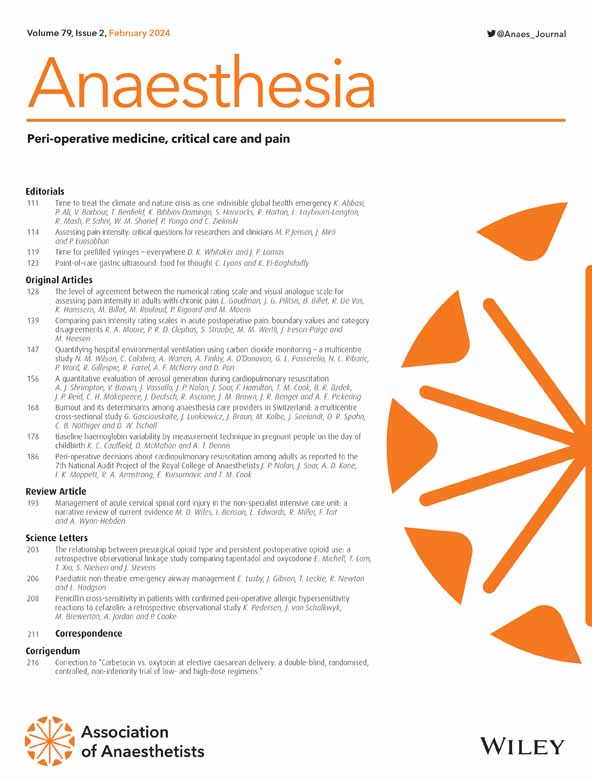Effects of anaesthesia and surgery on sleep–wake timing and subjective sleep quality in children: an observational study
IF 6.9
1区 医学
Q1 ANESTHESIOLOGY
引用次数: 0
Abstract
SummaryIntroductionSurgery and anaesthesia can cause disruption of the circadian timing system and diurnal sleep–wake rhythm. However, it remains unknown how sleep–wake rhythm in children is affected by anaesthesia and surgery, and if anaesthesia without a surgical procedure disturbs sleep–wake cycles.MethodsWe recruited children aged 1–11 y undergoing anaesthesia for an elective surgical procedure or magnetic resonance imaging. The Children's Chronotype Questionnaire, Children's Sleep Habits Questionnaire and a daily sleep diary from three days before until seven days after anaesthesia were used to assess sleep–wake rhythm and sleep quality.ResultsIn total, 117 patients (median (IQR [range]) age 4 (2–6 [1–11]) y, 56 (47.9%) female) were included. The midpoint of sleep did not change on the night after anaesthesia when compared with three nights before (estimated median time difference 8 min, 95%CI ‐15–1, p = 0.12, n = 114). Median (IQR [range]) midpoint of sleep at baseline was 01.42 (01.22–02.19 [00.10–03.15]) for the surgical group and 01.22 (01.03–02.07 [00.15–04.02]) for the magnetic resonance imaging group. The midpoint of sleep did not shift on the night after anaesthesia for either group (surgical group: 01.37 (01.07–02.15 [23.00–03.12]), estimated median time difference ‐15 min, 95%CI ‐27–0, p = 0.07, n = 58; magnetic resonance imaging group: 01.30 (01.07–02.07 [23.45–05.00]), estimated median time difference 0 min, 95%CI ‐9–9, p = 0.90, n = 56), and there was no between‐group difference (estimated median time difference: ‐15 min, 95%CI ‐30–0 min, p = 0.07). Subjective sleep quality was unaffected.DiscussionWe found no disruption of sleep–wake rhythm in children after anaesthesia and surgery. Further research is needed to see whether more invasive procedures and accompanying anaesthesia pose a risk of disrupting sleep–wake rhythms in children.麻醉和手术对儿童睡眠-觉醒时间和主观睡眠质量的影响:一项观察性研究
手术和麻醉可导致昼夜节律系统和昼夜睡眠-觉醒节律的中断。然而,目前尚不清楚麻醉和手术如何影响儿童的睡眠-觉醒节律,以及不进行手术的麻醉是否会扰乱睡眠-觉醒周期。方法我们招募1-11岁接受麻醉的儿童进行选择性手术或磁共振成像。使用《儿童睡眠类型问卷》、《儿童睡眠习惯问卷》和麻醉前3天至麻醉后7天的每日睡眠日记来评估睡眠-觉醒节律和睡眠质量。结果共纳入117例患者,中位(IQR[范围])4岁(2-6岁[1-11]),其中女性56例(47.9%)。与麻醉前三晚相比,麻醉后一晚的睡眠中点没有变化(估计中位时差为8分钟,95%CI‐15-1,p = 0.12, n = 114)。手术组基线睡眠中位数(IQR[范围])为01.42(01.22 - 02.19[00.10-03.15]),磁共振成像组为01.22(01.03-02.07[00.15-04.02])。两组麻醉后夜间睡眠中点均未移位(手术组:01.37(01.07-02.15[23.00-03.12]),估计中位时差- 15分钟,95%CI - 27-0, p = 0.07, n = 58;磁共振成像组:01.30(01.07-02.07[23.45-05.00]),估计中位时差0 min, 95%CI‐9-9,p = 0.90, n = 56),两组间无差异(估计中位时差:‐15 min, 95%CI‐30-0 min, p = 0.07)。主观睡眠质量未受影响。我们没有发现麻醉和手术后儿童睡眠-觉醒节律的中断。更多的侵入性手术和伴随的麻醉是否有破坏儿童睡眠-觉醒节律的风险,还需要进一步的研究。
本文章由计算机程序翻译,如有差异,请以英文原文为准。
求助全文
约1分钟内获得全文
求助全文
来源期刊

Anaesthesia
医学-麻醉学
CiteScore
21.20
自引率
9.30%
发文量
300
审稿时长
6 months
期刊介绍:
The official journal of the Association of Anaesthetists is Anaesthesia. It is a comprehensive international publication that covers a wide range of topics. The journal focuses on general and regional anaesthesia, as well as intensive care and pain therapy. It includes original articles that have undergone peer review, covering all aspects of these fields, including research on equipment.
 求助内容:
求助内容: 应助结果提醒方式:
应助结果提醒方式:


